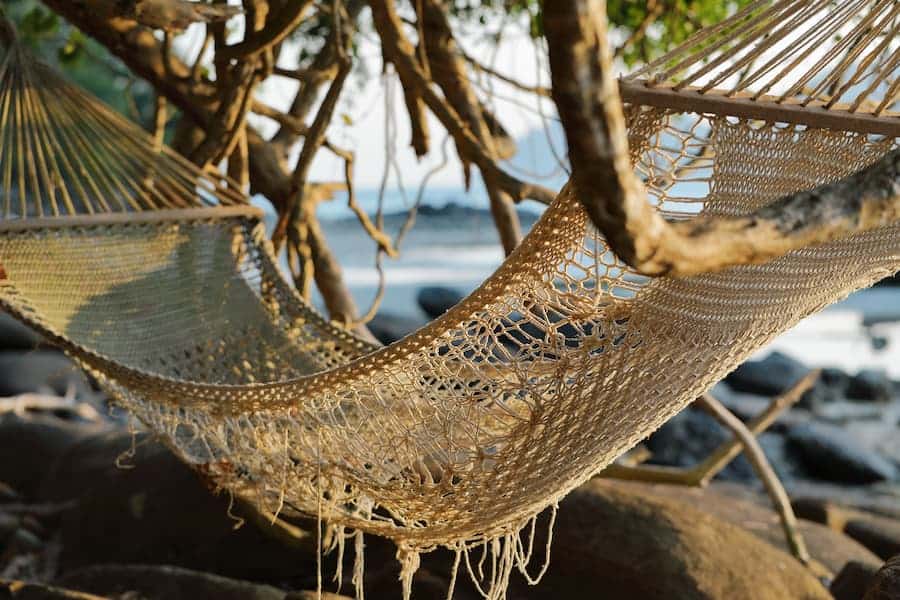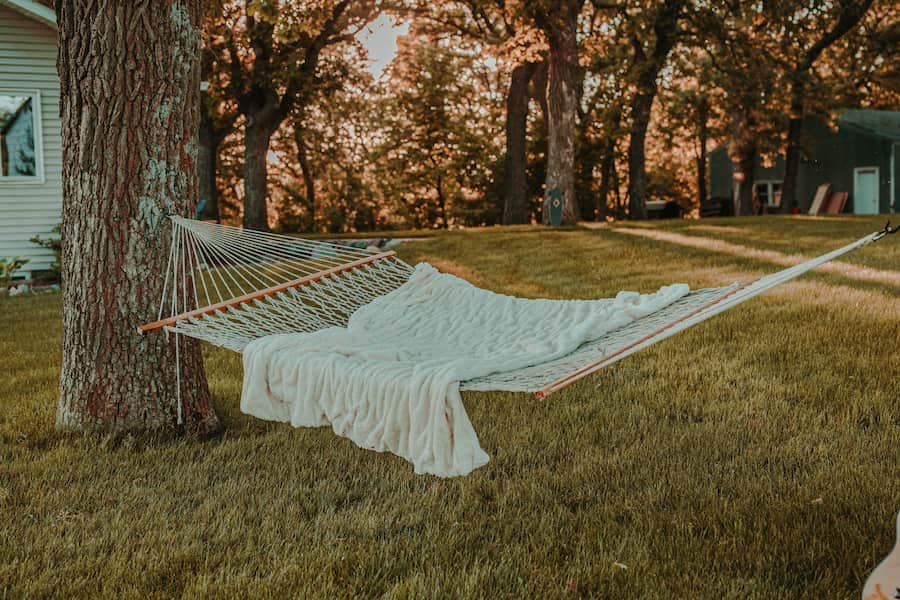As an Amazon Associate we earn from qualifying purchases.
Rope hammocks offer a suitable relaxing place to retreat to during the summer. As soothing as your hammock is, it is bound to collect some dirt and grime as you use it. Your hammock needs regular cleaning to maintain its durability.
You will need to familiarise yourself with how to clean a rope hammock, and luckily for you, we have compiled comprehensive information on how to do just that.
Contents
How to Clean a Rope Hammock
Cleaning a rope hammock is relatively easy. Spread it on a concrete surface or deck and then soak it using a garden hose. Pour a solution of soapy water and then begin scrubbing it. Ensure you avoid pouring water on the metallic parts. You can wipe those with a damp cloth.

1. Shake Off Loose Dirt
Shaking your rope hammock is meant to remove any loose debris and gunk from your hammock before starting the cleaning process. To do this, detach one end of the hammock, leaving the other end still attached in place. Shake the loose end up and down vigorously to remove particulate build-ups such as tree leaves, loose dirt, pollen, and dust from the hammock fabric.
2. Soak and Wash the Hammock
Some of the cleaning utilities you will need for washing the hammock include:
- Some mild detergent
- A bathtub or wading pool
- A soft-bristled brush
- Some warm water
- An efficient stain remover
Fill the bathtub or wading pool with water and add your detergent. Get your hammock and soak it in the water, ensuring that you keep the galvanized rings and any wooden parts out of the water. Allow your hammock to soak for around twenty minutes. Occasionally rub the ropes and fabric by hand from one end to another to remove preliminary dirt.
After twenty minutes have elapsed, pull out your hammock from the tub and lay it flat on a clean surface such as your outdoor deck. Get a detergent-dissolved bucket of lukewarm water and scrub off dirt from your hammock’s fabric and rope using a soft-bristled brush. Go ahead and flip the hammock over to clean the other side as well.
Once you finish scrubbing, spray down your hammock to rinse off all the soap. When your hammock is soap-free, wipe down the spreader bars with a clean cloth. Spread the hammock flat on a clean, dry surface or hang it up on a tree. Allow it to dry thoroughly before using it.
3. Remove Tough Stains and Stink
If you haven’t been cleaning your hammock regularly, you might find yourself having to deal with stubborn stains as well as an unpleasant smell from your hammock’s fabric. Your hammock may emit a nasty odor because it absorbs sweat. If your hammock has a bad smell, use some scented conditioner in your wash procedure to get rid of it and leave the fabrics of your hammock conditioned and pleasantly scented.
When dealing with stubborn stains, use a dry scrubbing brush to remove loose particles from the stain spots. Apply an efficient stain remover to carefully scrub off the stains without damaging the fabric of the hammock. Avoid using bleach to clean your hammock unless it is white to prevent discoloration of the hammock.

After your rope hammock is clean, make sure you:
- Always remove debris when you see it
- Do not machine wash the hammock pillow
- Store it when not in use
- Never leave it outside during extreme weather
Getting Rid of Bugs, Mildew and Algae
Bites from bedbugs can cause severe allergic reactions as well as secondary skin infections. A solution to get rid of these pests would be to get yourself some bug spray or potent insecticide to eliminate them before thoroughly cleaning your hammock to remove the dead bugs.
Mildew and algae are sometimes unavoidable due to the frequent use of your hammock during the summer. Molds thrive in high humidity levels and warm temperatures. Use a dry brush to scrub off loose mildew particles but be careful not to inhale the spores as they cause asthma and respiratory tract infections. Wear a mask for protection.
After scrubbing the particles off, it is time to prepare your homemade cleaning solutions to eliminate the mold stains. Pour vinegar onto the stains and leave it to sit for twenty minutes, preferably in direct sunlight. Use a soft brush to scrub at the spots ensuring to rinse the brush regularly.
Storing Your Hammock
As much as hammocks are an outdoor accessory, it is not advisable to store them outside. To avoid mildew and damage, you should keep your rope hammock in a cool, dry place that is moisture-free. Ensure that you place the hammock in a breathable bag and store it indoors, away from direct sunlight and dampness.
If you store your hammock in a garage or shed, it would be wise to place it in a weather-tight tote and suspend it high above the ground. Pests and rodents are prone to gnawing and scratching away at your hammock, leaving you with a destroyed hammock that is functionless. Suspension limits the reach of pests and rodents that would chew up the hammock fabrics.

Taking Proper Care of Your Hammock
As durable as the materials are, hammocks need regular washing and maintenance if your goal is to have them serve you for a long time. Paying no heed to care will have your hammock’s fabric fraying up and eventually breaking down before you know it. The last thing you want is to relax on your hammock, taking a soft nap peacefully, and suddenly the hammock tears in two.
Lack of proper hammock hygiene may have you contracting skin rashes from the accumulation of molds and make for an overall unpleasant experience. You should watch for any wear and tear on your hammock and ensure that you do not apply excessive weight to it. Watch out for a film of algae or mildew on your hammock, as these microbes are associated with severe health conditions.
Conclusion
Hammocks are easy to clean, and you can quickly repair any tears and damages on your own. As long as you keep your hammock clean and well maintained, you are bound to enjoy using your hammock for a long time. Keenly adhere to storing your hammock indoors after use to keep it away from the harsh outdoor elements that would quickly decrease the lifespan of your rope hammock.
